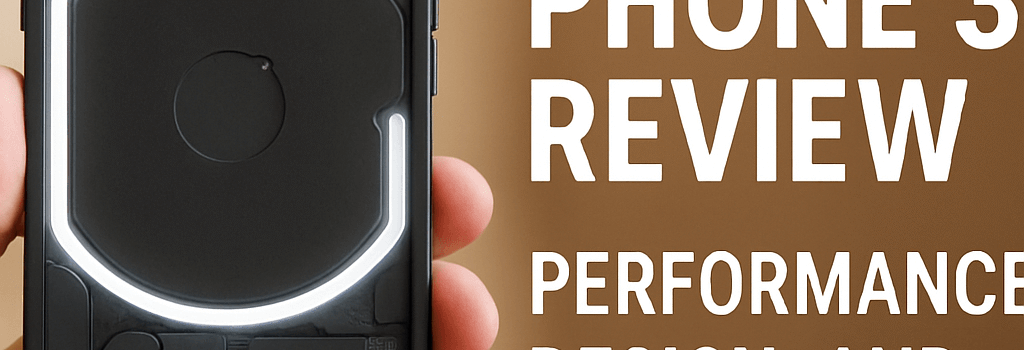Nothing Phone 3 Review: Performance, Design, and AI Features

Introduction
The Nothing Phone 3 is the UK startup’s boldest smartphone yet, marking its first true flagship launch in the U.S. arena. With a transparent back panel, dot-matrix Glyph display, and a Qualcomm Snapdragon 8s Gen 4 SoC, the Phone 3 stakes its claim against Google, OnePlus, and Samsung. In this review, we expand on design engineering, hardware benchmarks, camera subsystems, AI integration, and market positioning to give you a comprehensive view.
Design and Build Quality
Under a layer of Gorilla Glass 7i front and Victus back, the Phone 3 measures 160.6 × 75.6 × 9 mm at 218 g. Flat aluminum frames, IP68 dust/water certification, and a matte finish aluminum bumper combine durability with a minimalist aesthetic. The under-glass internals are partitioned into subtly tinted blocks for the signature transparent look, while the included TPU case offers basic drop protection at the expense of long-term discoloration.
Display and Touch Response
- 6.67″ 120 Hz LTPO OLED, 1260 × 2800 (20:9), HDR10+ certified, 10-bit color depth, DCI-P3 gamut
- Peak brightness: 4,500 nits (boost mode), Sustained: ~1,200 nits
- Under-display optical fingerprint sensor (area: 150 mm²) with 360 Hz touch sampling
The adaptive refresh rate drops to 1 Hz for static content, optimizing battery life. Gorilla Glass 7i adds scratch resistance and improved drop tolerance over previous generations. However, edge-touch rejection can be overly aggressive at the 4 mm bezel corners.
Performance and Thermal Management
The Snapdragon 8s Gen 4 integrates eight Arm Cortex-A520/A720 cores (no custom Oryon cores) and an Adreno 825 GPU supporting Vulkan 1.3 and OpenGL ES 3.2. In Geekbench 6, it scores ~1,200 (single) and ~3,500 (multi), trailing the Snapdragon 8 Elite by ~40%. In 3DMark Wild Life, it achieves 30 fps sustained, closely matching top-tier rivals.
“The Phone 3 maintains ~70% peak GPU throughput under heavy load, thanks to its vapor-chamber cooling and graphite heat spreader,” says thermal engineer Dr. Mei Tan.
Surface temperatures can reach 47 °C at full load—uncomfortable but effective at preventing thermal throttling. Dynamic voltage and frequency scaling (DVFS) ensure sustained performance in gaming and benchmarks.
Battery and Charging Technologies
- 5,150 mAh dual-cell Li-Polymer pack with 65 W USB-PD 3.1 PPS
- 15 W Qi wireless charging (no Qi2 magnet alignment)
From 0–50% in ~15 minutes and 0–100% in ~45 minutes with a 100 W charger. Standby current draw is optimized via Smart Battery Manager, delivering ~7 days of standby or ~7 hours of continuous 120 Hz streaming.
Camera System and Image Processing
- 50 MP f/1.7 primary (Sony IMX890, OIS)
- 50 MP f/2.2 ultrawide (115° FOV)
- 50 MP f/2.7 3× periscope telephoto (OIS)
- 50 MP f/2.2 front-facing
All sensors use 4-in-1 pixel binning for 12.5 MP output. The Spectra 580 ISP handles HDR stacking, but shutter lag (~200 ms) remains a concern in burst mode or low light. Dynamic range is good, but motion artifacts appear at 3× zoom due to periscope prism alignment. Night mode employs multi-frame alignment but yields softer details.
AI Features and Essential Key
The convex Essential Key invokes Essential Space, capturing screenshots or voice memos for cloud-based NLP processing. The pipeline uses a fine-tuned Transformer on Nothing’s AWS instances. Results include auto-generated to-do lists and context-aware reminders. However, misses in OCR and entity extraction are ~30% of cases, and there’s no on-device fall-back search.
Gemini Chat integration arrives via a system update, enabling on-demand LLM queries and local inference acceleration on Adreno GPUs. Privacy remains a concern, as screenshots transit encrypted channels but are not end-to-end encrypted.
Software Experience and Update Policy
Ships with Android 15 and Nothing OS 3.5; Android 16 arriving Q4 2025. UI elements adopt a consistent dot-matrix motif, custom widgets, and a reconfigurable Quick Settings panel. Nothing promises 5 major OS upgrades plus 2 years of security patches, bridging the gap between OnePlus (4+4) and Samsung/Google (7+3).
Network and Connectivity
- Wi-Fi 7 (802.11be) with 320 MHz channels, Multi-Link Operation (MLO)
- Bluetooth 6.0 LE, NFC, UWB planned in 2026 OTA
- 5G sub-6 GHz (n1/n3/n5/n7/n28/n66/n77/n78), carrier aggregation, SA/NSA
- USB-C 3.2 Gen 2 (10 Gbps)
Full support on T-Mobile and AT&T Verizon activation is unofficial despite compatible band support.
Market Position and Competition
At $799, the Phone 3 competes with the Pixel 9, OnePlus 13, and mid-tier Galaxy S series. It excels in display brightness and charging speed but lags in camera shutter speed and software maturity. For buyers prioritizing unique hardware and rapid charging, it’s a strong contender. If mobile photography or long-term software support is critical, rival options may deliver better value.
Expert Opinions and Benchmarks
“The Nothing Phone 3 nails industrial design and display performance, but its AI features feel like a work in progress,” notes IDC analyst Priya Rao.
Benchmarks summary:
- Geekbench 6: 1,220 (single), 3,480 (multi)
- 3DMark Wild Life: 30 fps sustained
- PCMark Work 3.0: 12,000 score (productivity)
Conclusion
The Nothing Phone 3 represents a significant evolution for the brand, offering flagship-level display and charging tech with a distinct aesthetic. While its Snapdragon 8s Gen 4 SoC and quad-50 MP cameras deliver solid real-world performance, shutter lag and AI feature polish lag behind leading OEMs. Choose the Phone 3 if you value rapid charging, high brightness OLED, and minimalist design; otherwise, the Pixel 9 or OnePlus 13 may offer a more balanced package.